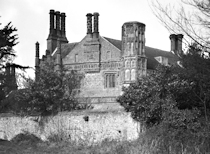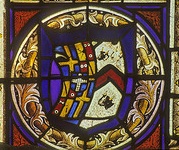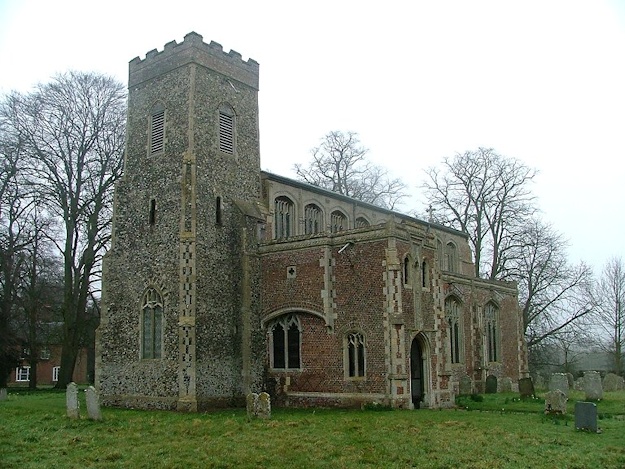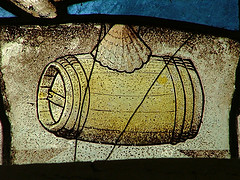The Manor House at Great Snoring, formerly known as The Rectory, was built in the 1400s by the Shelton family.
Gwen Bolton who lived in the village in the 1970s wrote about the family and the article appeared in Norfolk Fair, November 1975 .

Gwen Bolton who lived in the village in the 1970s wrote about the family and the article appeared in Norfolk Fair, November 1975 .
Historian Blomfield says the family took their name from the village, although they came there from Stradbroke in Suffolk
 Although the family seems to have been at its zenith in Tudor times, two earlier members made their mark on our history, for Nicholas de Shelton took part in that
revolt against King John which culminated in Magna Carta, and Sir Ralph (whose coat of arms is seen here) fought at the battle of Cresy and was rewarded with a knighthood by Edward III.
Although the family seems to have been at its zenith in Tudor times, two earlier members made their mark on our history, for Nicholas de Shelton took part in that
revolt against King John which culminated in Magna Carta, and Sir Ralph (whose coat of arms is seen here) fought at the battle of Cresy and was rewarded with a knighthood by Edward III.
Sir Ralph's first wife was Ann Bourgiloun, whose family had held the lordship of Great Snoring for generations and who, when she married into the Shelton family, brought the lordship with her.
A brass on the chancel floor in the church of St Mary the Virgin at Great Snoring represents one of their sons, Randalphus Mellon, who died in 1424, and his wife Alicia, daughter of Thomas de Livedale of Telcolneston.
Randalphus seems to have been succeeded by his brother William.
About this time the family acquired the manor of Barrets in Hardwick, probably by the marriage of William to Catherine Barret of Hardwick and Heacham. Fragments of medieval glass surviving in the windows of St Margaret’s church, Hardwick, showed the Shelton arms. William ‘left all’ to his heir John, who died at the age of 24, leaving a three month old son, Ralph.
By the time he came into his inheritance, Ralph’s fortune had increased handsomely, and the family’s star began to rise. Ralph was present at the coronation of Henry VII's Queen, he was knighted, and he started to build. He built the original Hall at Shelton, into which he moved from an earlier house.
Both these house have long since vanished, though we may perhaps have some idea what Sir Ralph’s Hall looked like, for a Shelton daughter married Sir Edmund Bedingfeld, and their house, the beautiful Oxborough Hall, is supposed to have been built on the lines of her house at Shelton. The only remains of Sir Ralph's semi-fortified ‘investment in personal safety’ at Shelton are below ground level walls and the wetness of the moat.
But the house he built at Great Snoring is still standing, beautiful and lived-in, nearly 500 years later; a substantial part of it still as its builder intended it to be.
Sir Ralph also built the nave of the church at Shelton, replacing an earlier one and he left instructions in his will for finishing the work should he die before its completion.

He married twice, first a lady whose identity is uncertain, and secondly Margaret, daughter of Robert Clere of Ormsby. Walter Lybert, Bishop of Norwich, by his will dated 1472, left Sir Ralph's daughters a hundred marks each, 'at the day of marriage'.
Sir Ralph was appointed High Sheriff of Norfolk in 1487 and died ten years later, his work on the church still unfinished. Although the work stopped, the interior of the church is full of reminders of the family; their tombs, their rebus, their arms and, in the glowing east windows, their portraits and those of two of their kings.
Astley, in his 'Memorials of Old Norfolk', suggests that Skelton, poet laureate to Henry VII, may well have been of the Shelton family, since the poet had a Norfolk background and the names of Skelton and Shelton seem to have been used indiscriminately.
Sir Ralph's son, Sir John, married the daughter of Sir William Boleyn of Buckling, and was too much Involved in court matters to pay much attention to his father’s wishes regarding the completion of Shelton church. Lady Shelton was the aunt of Anne Boleyn, Henry VIII’s second wife, and was chosen to be governess to the Princess Mary, the King’s daughter by his first wife, Catherine of Aragon. Perhaps Queen Anne Boleyn was responsible for her aunt’s appointment.
When the King’s interest in Queen Anne had waned, and a new lady had caught his eye, the Boleyn’s evidently felt it politic that, if there had to be a new favourite, it would be as well to have one who had the family's interest at heart, so Margaret, daughter of Sir John and Lady Shelton and cousin to the Queen, was brought to court. ‘Pretty Madge’ apparently sucessfully weaned the King away from the lady, and the family was presumably able to rest more easily until the advent of Jane Seymour. Margaret later married Thomas Wodehouse of Kimberley.
When Queen Anne was executed, her daughter, the future Queen Elizabeth, was also put into the care of her great-aunt, Lady Shelton.
Poor little Elizabeth was the victim of plot and counterplot, and on one occasion so close was the danger to her person that her great-uncle had to hide her in the tower of Shelton church.
Sir John died when Elizabeth was six years old. He had served twice as High Sheriff of Norfolk, and had had a grant of Carrow Abbey in Norwich, where, says Walter Rye, there was a fine series of armourial glass of the Sheltons. He furnished two rooms there after the Dissolution, and in her will his wife is described as being ‘of Carrow’.
His heir, another Sir John, also served twice as High Sheriff He was knighted in 1546 and married Margaret, daughter of’ Sir Henry Parker. He joined Mary Tudor at Kenninghall ‘to advance her to the Crown', a gesture which can hardly have endeared the family to Elizabeth when she became Queen.
Certainly the Sheltons were never again so close to the throne. Indeed we find Sir John Boleyn of Blickling, in his will, beseeching Queen Elizabeth to give his niece, a Shelton daughter, the £400 which the Queen owed him, his niece being now ‘utterly destitute’: The circumstances in which a daughter of the Sheltons should be in such dire straits remain an intriguing mystery. Perhaps it happened late in the reign, when the Shelton star had already set, and the daughter in question was very old and the family fortunes at a low ebb. Or perhaps, as the Queen always found borrowing money more profitable than repaying it, it was a last desperate bid by Sir James to retrieve the money for the family coffers.
In the early 17th century the manor of Great Snoring was sold to Thomas Richardson, afterwards Speaker of the  House of Commons and of the King’s Bench.
House of Commons and of the King’s Bench.
The Tudor Sheltons seem to have shared the contemporary passion for puns - the shell and tun decorations in the church at Shelton and on the door of their manor house at Great Snoring, bulls’ heads for the connection with the Boleyns, and Sir Ralph’s remark when he sold to Thomas Richardson that he could ‘sleep without Snoring’.
The Manor House is today a Guesthouse.
The Snoring Villages: a website for those researching their family trees, and for anybody curious about the history and whereabouts of these two small villages in Norfolk, UK.
I no longer live in Norfolk. I cannot visit graves, make local enquiries or provide contacts for you. Please be aware that I have no information other than that on this website..
Address: Derbyshire, England
Telephone: Unavailable
E-mail: tricia (at) the-snorings.co.uk
© Copyright 2012 Tricia Booth.
Design by Dream Web Templates





